The challenges facing the High Street have been much in the news over the last few years, with the failure of many shops and restaurant chains. This is the latest manifestation of a process that has been changing the way we shop for many years. It was not so long ago that the corner shop was the main source for day to day provisions. A corner shop could be found on the majority of London streets and the outline of many of these remain to this day, and for this blog post I went in search of one we photographed in 1986 to see what remained. This is the Walcot Stores in Walcot Square, Lambeth:
The same view today:
The Walcot Stores has long closed, but parts of the painted sign and the shop front remain. The conservation appraisal for the area records about the shop front that “Despite some surviving elements, unfortunately the door and much of the timber has been replaced and inappropriately stained.”
Looking into the original shop reveals a mix of goods. Tins of soup, boxes of fruit juice, packets of biscuits and in the left hand window, household cleaning products, toothpaste and soap.
Walcot Square is in Lambeth. Follow the Kennington Road, and just after the grounds of the Imperial War Museum are a couple of streets that lead into an early 19th century development centered on Walcot Square.
in the following map, Kennington Road is the vertical orange road in the centre. The Imperial War Museum is at the centre top, and just below this is the Walcot Estate centred around two triangular greens, just to the right of Kennington Road.
Map © OpenStreetMap contributors.
The Walcot Estate is one of those places that can be found across London which have a very distinctive character and are different to their surroundings. I have written about similar estates before, such as the Lloyd Baker estate.
The land in this part of Lambeth was once owned by the Earls of Arundel, then the Dukes of Norfolk. In 1559, Thomas, Duke of Norfolk sold a parcel of land, and in 1657 this land was sold to Edmund Walcot.
There must have been a family connection to the area as Edmund’s uncle, Richard Walcot also owned some local land which Edmund inherited.
Edmund left the land in trust to St. Mary Lambeth and St. Olave, Southwark, for the benefit of the poor. At this time the majority of the land was undeveloped, apart from some limited building, it was mainly used for agricultural purposes.
The land left to St. Mary and St. Olave went through a number of partitions, enabling the two parishes to own their specific block of land, with the line of the present day Kennington Road roughly forming the border between the partitioned land.
Building commenced in the early years of the 19th century. Walcot Square was constructed between 1837 and 1839.
The name Walcot Square does not fit the area. Walcot recalls Edmund Walcot who left the land in trust to the parishes, however the area is not really a square.
The grassed section in the middle is more a triangle than a square, whilst the name also extends along the road that leads down to Kennington Road and up towards Brook Drive.
The Walcot Stores were at the eastern end of Walcot Square, towards Brook Drive. After photographing the old store front, I walked along Walcot Square towards the central grassed area.
In the following photo, the old shop is in the building on the left. In the front of the single storey building is a very old looking stone.
A closer examination reveals a stone with a number of inscriptions. The date appears to be 1779.
The stone pre-dates the construction of Walcot Square so was probably a boundary stone, possibly to show the land had been partitioned between the parishes of St. Mary and St. Olave.
I checked John Rocque’s 1746 map to see if I could find any obvious boundary (assuming that the boundary was in place 33 years before the date on the stone).
The following map extract shows the area in 1746.
Some of the main roads that exist today could also be found in 1746. Part of Kennington Road along with Hercules Road, Lambeth Road and Lambeth Walk.
I have marked roughly where Kennington Road extends today and also the area occupied by the Walcot Estate, which in 1746 mainly consisted of fields.
There is a very hard boundary running diagonally down from Lambeth Road with cultivated agricultural land on the left and open fields on the right. This may have been the partition between St. Mary and St. Olave’s land, however the boundary does not look to be where the stone is to be found today – this is assuming that the stone is in the original location, Rocque’s map is correctly drawn and scaled, and that my interpretation of where the future extension to Kennington Road would run, and the future location of the Walcot Estate is correct.
Again, one of the problems with my blog where I worry I do not have enough time to research the detail – however I found it fascinating to find that a boundary stone that pre-dates the building of the entire estate can still be found.
Walking from the location of the shop, a short distance along Walcot Square brings us to the main area that could be considered a square. Here, the view is looking in the direction of Kennington Road with one of the corners of the triangle of grass, and the houses of Walcot Square on either side.
The square and housing was built between 1837 and 1839. The Kenning Road extension had already been built, along with the large houses that faced onto Kennington Road, so Walcot Square was the typical expansion of building back from the main roads into the fields.
The square consists of two and three storey houses, along with a small basement. the ground floor is raised so a small set of steps leads up from the street to the front door.
The north western corner of the square ends in a short stub of a street. The large gardens of the houses facing onto Kennington Road block the street. On the left is a rather attractive single storey building with a part basement below. The unusual design is probably because of the limited space behind, as this building could not intrude into the gardens of the house on the left.
I wonder if it was the original intention to purchase the houses and land that block the extension on to Kennington Road and extend the above street and Walcot Square housing directly onto Kennington Road?
Leaving Walcot Square, walk along Bishop’s Terrace and you will find St. Mary’s Gardens (which must have been named after St. Mary, Lambeth, one of the parishes that had received the land in trust from Edmund Walcot). The layout is almost a mirror image of Walcot Square, with a triangular central garden.
St. Mary’s Gardens was built at around the same time as Walcot Square so is of 1830s design and construction.
Compared to the continuous stream of traffic along Kennington Road, the streets of the Walcot Estate are quiet, and apart from the street parking, the general appearance of Walcot Square and St. Mary’s Gardens are much the same as when the estate was completed in the 1830s.
Walking back to Kennington Road, there is another of the typical 19th century standards for estate building. As with shops, pubs were also a common feature at the end of a terrace, or corner of a street, here at the junction of Bishop’s Terrace and Kennington Road:
The pub was until very recently the Ship, but appears to have had a name change to The Walcot 1830 – a clear reference to the construction decade of the adjacent estate.
Lost Prefabs
Nothing to do with the Walcot Estate, but these must be in the local area.
The photo adjacent to the photo of the Walcot Stores on the strip of negatives from 1986 shows some prefab houses:
Whilst the prefabs have almost certainly long gone, I was hoping that the distinctive building in the background could still be found, however after a lengthy walk through the streets of this part of Lambeth, I could not find the building in the background, so the street in which these prefabs were to be found in the 1980s remains a mystery.
It would be great to know if any reader recognises the location.




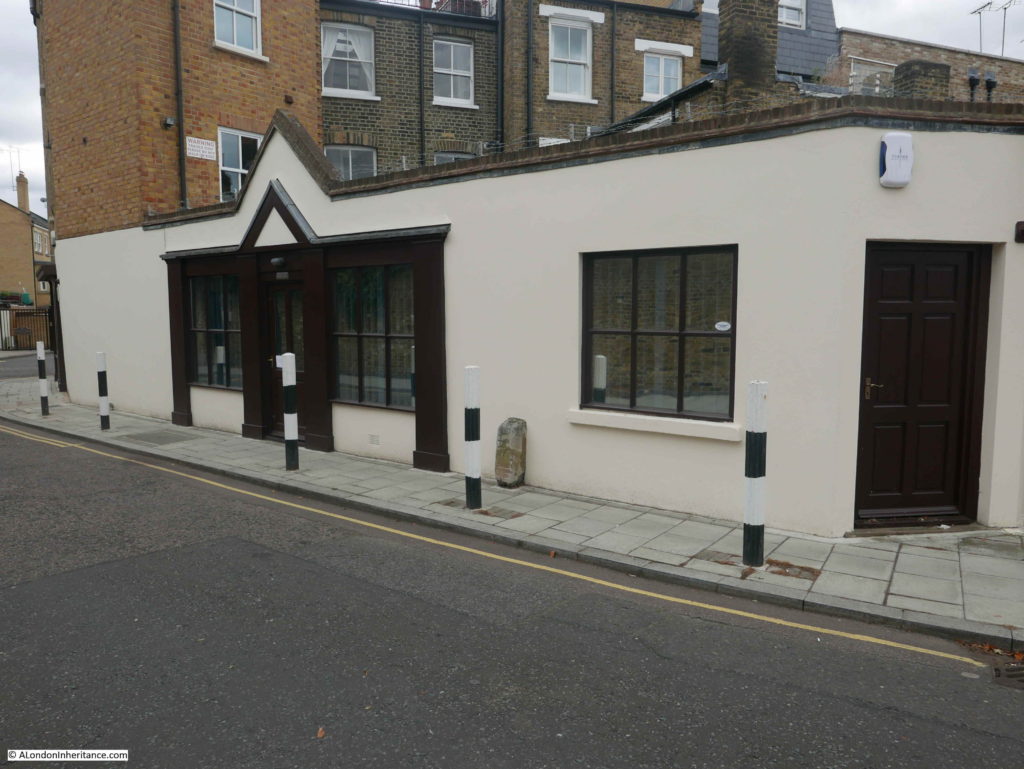

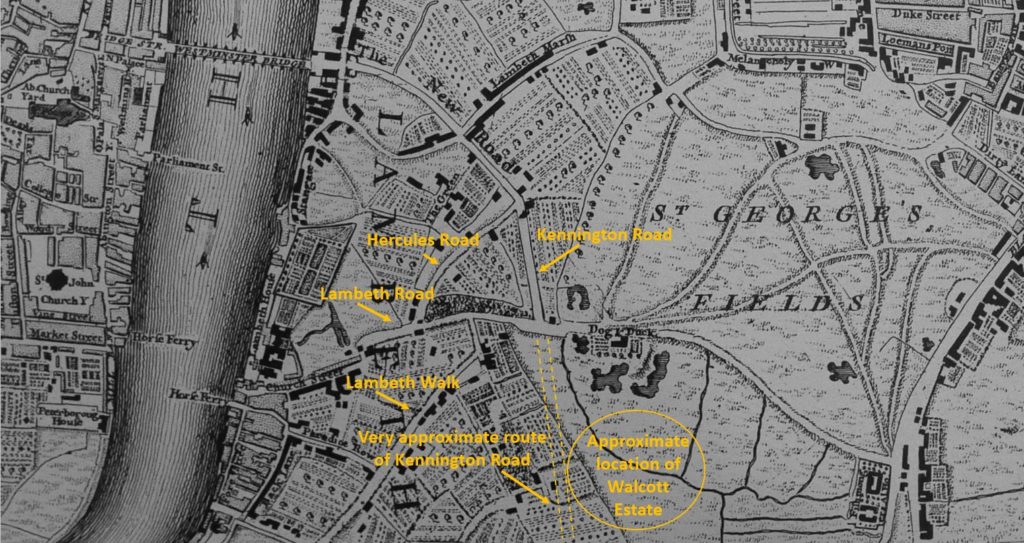
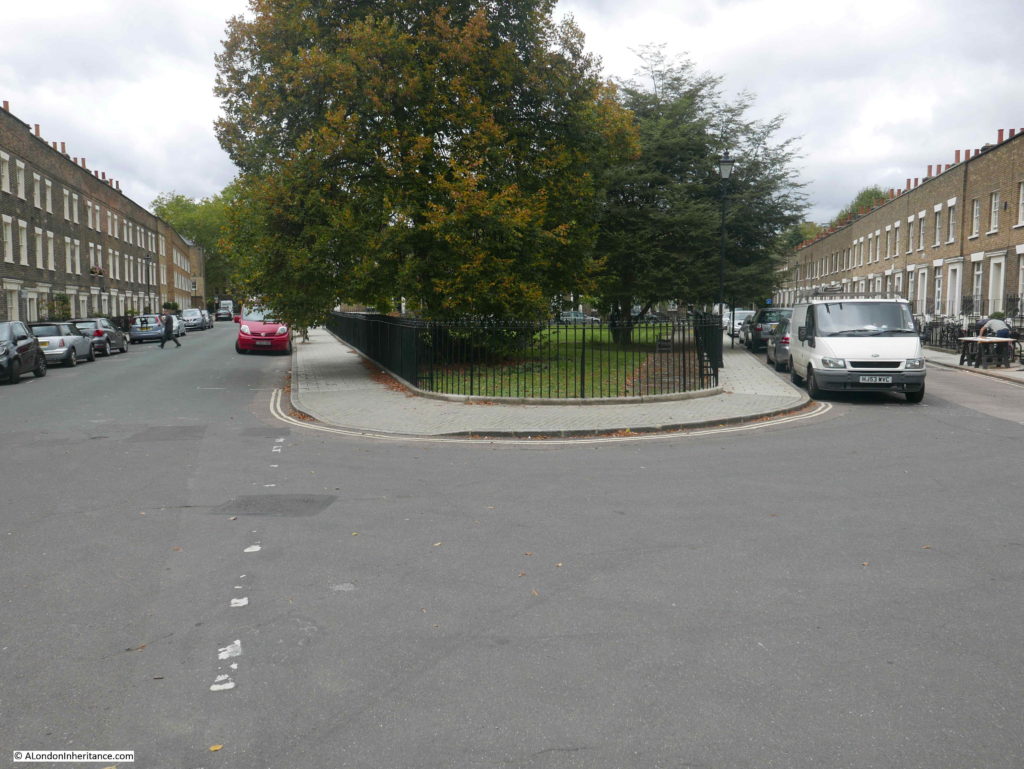
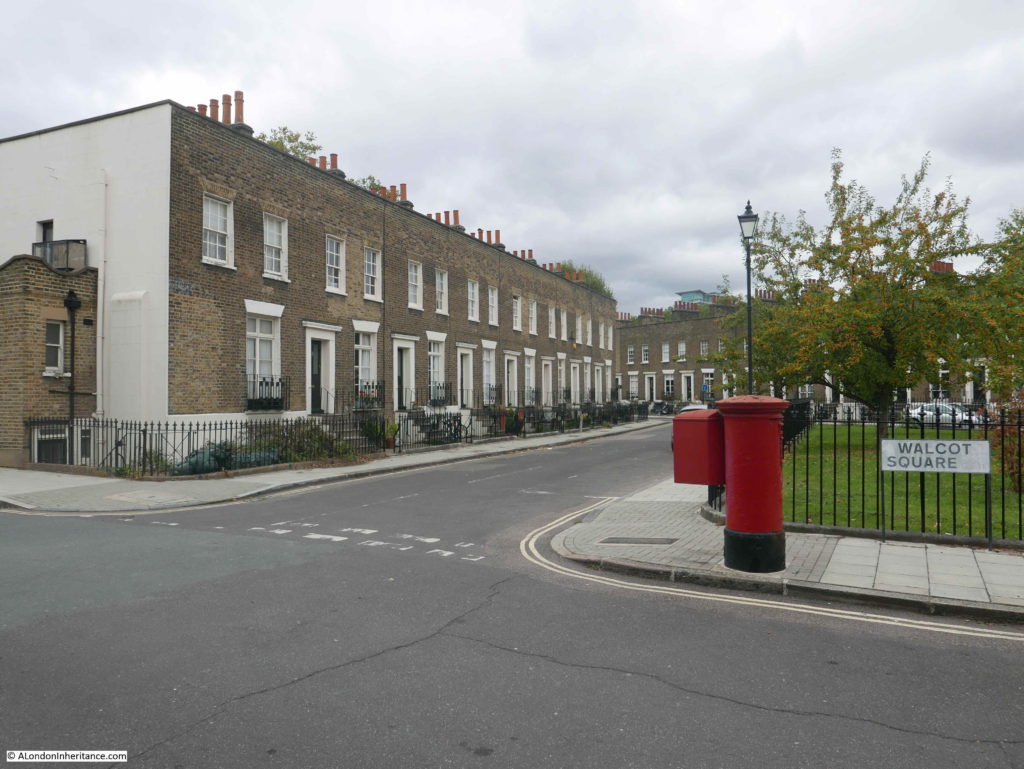
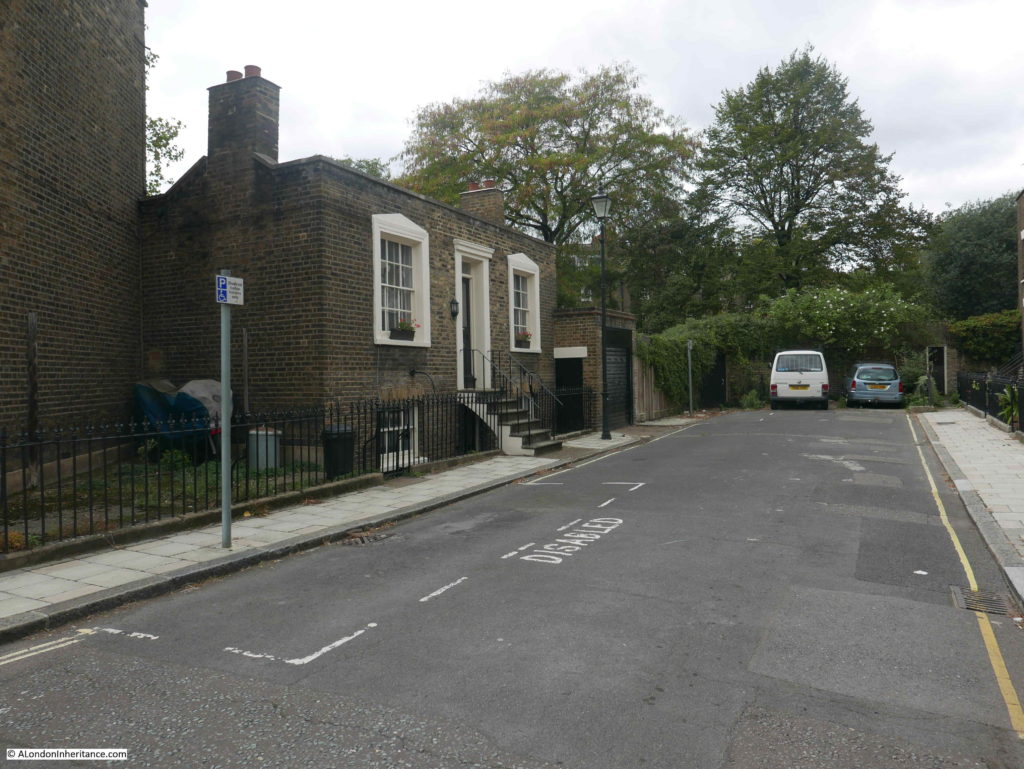

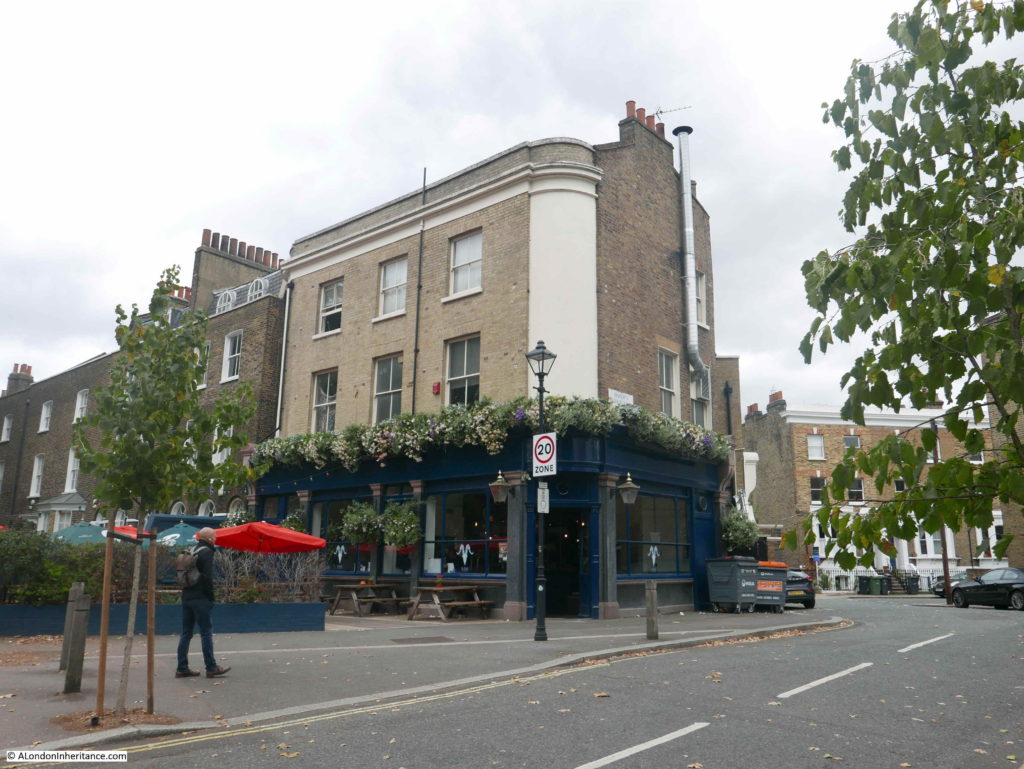

Think that building in the background of the prefab photo is the old London Park Hotel
Max, thanks for the quick identification. No wonder I could not find the location today.
Just to add that before being converted to the London Park Hotel, the building was one of many Rowton Houses dotted about London and elsewhere. I understand they provided cheap lodgings for the working man.
All credit to Max Davis above; yes, it seems to be the old London Park Hotel.
The are a few shots of the hotel off the Daily Mail site. In fact there seems to be a match for the air vent seen in your image. Dependant on a slight hill in the area, and some buildings be post 1980, I think the shot was taken in Dante Road, near the intersection of George Mathers Road, looking toward Longville Road and the intersection of Brook Dr and Elliot’s Row.
There seems to be a match in google maps, of both the rectangular air vent building in the foreground (in the ruins of the hotel site), then the distinctive two types of chimney pots in the first building in Elliots Row (image below from Google st view looking up), plus the row of chimney pots in Brook Drive, the only distinctive matching structure still in the area. The buildings in Longville Rd and alone Dante Road have to be post 1980 additions for the image to match – otherwise it’s a false positive! See here for a quick image match. https://drive.google.com/file/d/1nIYKIfc8I6hOWwcwuK8Omq4jnwPlSDpC/view?usp=sharing
As Max says the building was the London Park Hotel between St Mary’s Churchyard and Dante Road. The prefabs look as though they were on the site of what are now the LSBU student halls.
Thanks Jon, the location of is not far from the Walcot estate so makes complete sense. I will have to take another walk around the area.
And here’s an image showing “… Prefabs at Dante Rd, off Newington Butts from London Park Hotel window 1973. From here https://www.flickr.com/photos/antydiluvian/ …
https://twitter.com/SouthwarkNotes/status/613078975854854144/photo/1
It would be glorious if, in the corner of the above image, was the grill of that ubiquitous air vent!! A quick look at google earth shows the water tower still existing.
Peter, thanks for the details and the links. Also checked on Google and the water tower still appears to be there. I will have to take another walk around the streets, but brilliant to track down the location of this photo. Thanks.
The water tower was featured in Grand Designs, S12 E05. The episode is available in the UK for free on the All4 app. The surrounding LSBU development was completed at the time of filming.
Excellent story on Walcot Road and that almost hidden part of Kennington. May be of interest, here is a film I made about the repair (not restoration) using traditional materials and skills of a Georgian house in Kennington:
Re the prefabs, these are the later LCC Mobile Homes from 1962 onwards, produced to alleviate the still-then shortage of affordable housing. In the book Prefabs published by Historic England, these are shown with the London Park Hotel and the water tower of the Lambeth Hospital in the background.
Well spotted. I didn’t think they looked like 1940s pre-fabs.
Interesting that your extract of John Rocque’s map is different to the one I normally refer to here: https://www.locatinglondon.org/
Maybe not surprising that there’s more than one copy in common usage… or if one is an update of the other…
In which “The Green” and “Back Lane” appear to be the later Carlisle Lane/Street, where my 2 x great grandfather grew up and lived until the mid-century, moving into other adjacent streets presumably as the railway viaduct expanded. As both he and his presumed stepfather were building tradesmen (one a painter/plasterer/paperhanger, the other a bricklayer) I shouldn’t wonder if one or other had a hand in work on these, either building or later maintenance.
Lovely properties, so glad they have survived despite the present blitz of apartment blocks…
The water tower was the subject of the Chanel 4 programme Grand Designs a few years ago.
I thought that I recognised the brick building – so thanks for bringing back a memory of the hotel, and those times. I was a student at the London College of Printing (now UAL) at the Elephant between 69 and 73, and remember wandering around these backstreets in lunch breaks. The hotel was one of the cheapest around at the time I think – probably because it was regarded then as an “off location”, to use a Trumpian phrase.
Re Lost Prefabs
Is this photo of any help?
https://www.pinterest.co.uk/pin/724375921286835255/
Interestingly, the Walcot Stores where used in the 1990 film, The Krays. It appears about 1h15 minutes into the film.
The following two links show the Dante Street prefabs and the ‘hotel’, providing some context. https://tinyurl.com/ybxnwwts and https://tinyurl.com/y9x2ad8h
Struggling a bit to relate the pitched roofs in background to aerial pictures of Brook Drive/Longville Road where it looks as though buldings had flat roofs. See: https://britainfromabove.org.uk/en/image/EAW000541. Nevertheless all else fits with Dante Road site.
Fantastic piece that brings back many fond memories of living around there from the 60’s through to mid 80’s.
Re – London Park Hotel. Can remember in my youth it being a Rowton Hose prior to conversion/demolition.
http://www.workhouses.org.uk/RowtonNewington/
The surrounding area was mostly bomb sites prior to the prefabs being built with Securicor I think owning the land that the current leisure center occupies. The was a row of terraced houses behind the prefabs with a quaint old corner shop (run by two sisters) at the junction of Brooke Drive & Dante St.
The corner shop featured was our local one and the other shop fronts at the end of Walcott Sq were maybe something to do with the printing trade. There was also a bakers at the junction of Brooke Drive & Monkton Street that has since been converted to a residential property, the same with what used to be an old fashioned newsagents (Wells) across the road at the junction of Austral street.
There were also some older style prefabs at the top of Monkton St near to the junction with Wincott Street that were demolished to make way for a centre for the disabled (since converted to a primary school)
Thanks again for a great article.
Yes the prefabs are at the bottom end of Brooke Drive at Elephant and Castle and were replaced by a Holiday Inn. This in turn has now been demolished to make way for modern flats and some open space.
I could give more detail but am alas a bit rushed this morning!
There were a few prefabs on Walcot Square/Bishops Terrace but not LCC mobiles. The ones on Dante Road were preceded by a group of 6 American prefabs shipped over in 1945. See the Prefab Museum map for locations of post-war prefabs and LCC mobiles https://drive.google.com/open?id=18q5JrbCHY6xgApGl21wp8SCXzurt0AUB&usp=sharing
Fascinating as always. My wife’s great grandparents, the Picketts, lived in Walcot Square in the 1920s-40s and we think ran Walcot Stores for a while. In the 1939 Register they lived at number 12. John Pickett (d.1948) was a ‘grocer (own account)’ and his wife Lavinia (d.1974) was an ‘assistant in the shop’. Walcot Stores (number 68) was unoccupied in the Register.
The Metadyne site has info on the roadside stone, suggesting it marks part of the Walcot Estate boundary, and giving an onward link to a map of the Walcot Estate.
http://www.metadyne.co.uk/n-PropertyAndOtherMarks.html
Be prepared to spend hours diverted by Metadyne’s astonishing collection.
Kelly’s Post Office Directory 1910 (available online at Special Collections, University of Leicester) lists these occupiers for the square by street number (up one side and down the other) and then surname:
2 Shute John Chas. house decoratr
12 Vining George, grocer
St. Philip’s Mission Room
64 May Mrs. Mary, oil warehouse
68 Ram Walter grocer
95 Susans Albert Geo. greengrocer
89 Scott Joseph Edward, chndlr.’s sh
85 Stone Mrs. Eleanor, shirt & collar dresser
And thank you to “Prefab Museum”. I had no idea there had been prefabs in Pimlico, shown briefly in the 1959 film “Expresso Bongo”. Well that’s a story for elsewhere. Isn’t it amazing what our host’s pages cause to be discovered.
https://britainfromabove.org.uk/en/image/EAW029840
This photo from the excellent Aerofilms archive shows where the prefabs in Walcot Square were situated.
Having grown up in Walcot Square, I do remember the prefabs, long before they were demolished.
Beneath the central/garden is a large WWII bomb shelter, which was subsequently covered over.
My Great Aunt Beatrice Holben lived at 69 Walcot Square. She moved into the house when she was 8 years old and remained there until 81 years old, when she died at St Thomas’s Hospital. I spent quite a lot of my childhood at Walcot Square staying with my Great Aunt. My mother also grew up in that house so it has a special place in my heart. My mother and her brothers would recall stories of going down the shelter, which was under the central green. We would go to the bakers and buy lovely homemade bread, the best I have ever tasted.
My grandmother lived at number 73,I think your great aunt was her friend, I remember the name Beatrice and recall seeing her in my grandmother’s house.
Hi,
In 1993 I worked for Wimpey Construction and built the student accommodation for south bank poly . There were still a few prefab standing and one was actually occupied . We set up our site offices next door to them .
I also remember Walcot stores and used to pop in there now and then.
Regards
Steve
Those prefabs look familiar when I used to visit london to see family when I was a kid those look like the prefabs around the corner from bob whites fish shop in kennington lane
I used to live in St. Mary’s Gardens.
Please excuse my corrections on your assumptions, but I think you would rather know the truth, no?
https://www.walcotfoundation.org.uk/walcot-estate.html
The foundation that Dad paid rent to, gave education to underprivileged kids.
A snippet from the webpage:
“The Hayle’s and Walcot charities built hundreds of local properties in the 18th and 19th centuries, including Walcot Square and some surrounding streets in the 1830s.”
Another part of their estate was Walcot Gardens – building of flats, not a square – 136 Kennington Road. Opposite The Ship pub on the corner of Walnut Tree Walk.
Some other things to know. The street to the side of the Stores is Sullivan Road & the other end of the road is Monkton St. It was (probably not now though) the only street in London with 2 names in such a short length of uninterrupted road.
The Walcott Stores were actually 2 shops. The single storey building was the other part, but in the middle was the family part. Customers would have to walk around on the street to enter the other shop & usually the teenage boy would run through, to attend you on the other side. In the time I remember (early 1970 – late 90’s), it was run by an Indian or Pakistani family. The corner shop was dark inside, but many shelves – well stocked. The single storey shop with its loud bell was usually unattended until the bell was heard. It was a haberdashery, kitchen utensils & home supplies – basically everything you could want type of shop.
There were restrictions for the front of our buildings. No additions. No satellite dishes etc. This was because they could hire our the locations to film & TV companies for period pieces. I grew up with quite a few film companies & even went into television myself.
Every summer, the green in Walcot Square was opened for 1 day & a party for the kids & adults was held. Also, another party was held for all, in one of the gardens of the Kennington Rd houses. The main office was near the bus stop on Kennington Rd.
The prefabs had 2 of my friends from primary school there. In 1977, the residents were relocated to other parts of Lambeth – blocks of flats. The prefabs lay empty for years until they were knocked down & nice new buildings were erected for residental places for students of South Bank university (I believe).
If you need any other info, let me know.
Take care, Leslie 🙂
Great to see Walcot Stores as it was during my childhood. The store had a prominent role in the Krays film with the Kemp brothers. The shop sold groceries at the front store, this led into the hardware/oil shop where we would purchase canes to make bows and arrows as kids.
The prefabs were in Dante Road and were erected in the 1960s I think. At the rear of the photo.is Rowton House which was a hostel for men, this later became London Park Hotel which was later demolished to make way for the Uncle building, high and low rise housing, private and social.
Southwark Council and developers have destroyed some great architecture from the Elephant along with the areas unique character.
Walcott Stores was the location of a corner shop visited by Reggie Kray in the 1990 film The Krays with Gary and Martin Kemp. It had an older painted sign and the woodwork was painted brown, still with the shop interior intact. Anoit half an hournor so into the film.
The shop is still there but it is a private residence now. Most of the shops, butchers, bakers, newsagents, hairdressers etc. were forced to close because of the massive rate increases by the local council. They can’t destroy our memories though. “Come on Eileen” video shows the area quite well also.
Hi John just to say my family on both sides lived and owned businesses in Wolcott Square, and had a shop on the Kennington Road opposite the ship pub, this was the electrical shop that sold anything from batteries to oil filled radiators, this gentleman was a Mr Lewis, who was my mother’s father, my grandad he also had his offices in Wolcott Square on the corner, where the hairdressers used to be.
My father was a man called Mr Hardey and his dad was Hardey’s the cobblers or for the modern generation shoe repair shop, also my grandad, this was situated slightly further up on the same side of the road as the Wallcot square corner shop, I believe no 67 wallcot square.
As a child, I remember the Queens Jubilee Street party, and the area being used for filming for tv and films as you say.
My weekend consisted of going swimming at the elephant Castle Lido going home for lunch, spending the afternoons visiting the imperial war museum, which never got boring or playing in its park with climbing frames, sand pits, and also paddling pool, for the more adventurous and slightly older children, we had the adventure playground which consisted of telegraph polls lash together, planks of wood as runners and platforms to stand on all at different levels, all nail together in different precarious shapes with slide ropes just add for fun, it’s a wonder how we all got away with no broken bones, but we loved it. I believe these were outlawed in the late 80s, something to do with health and safety.
I have very fond memories of living and growing up in this area as a child don’t get me wrong you had to have your wits about you, outside the square it was no different to the rest of the world, but inside the square it was like a little Oasis, you had a sense of community, and everybody knew everybody.
Thank you for a trip down memory lane Mr Rob Hardey.